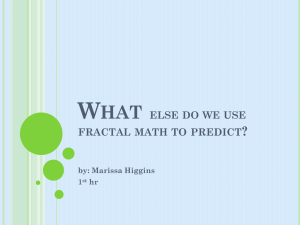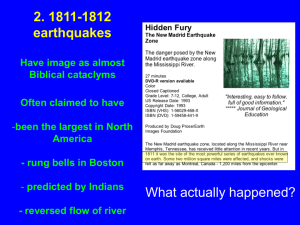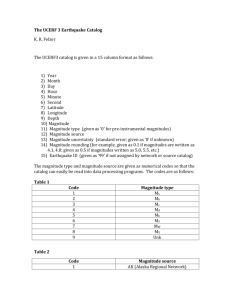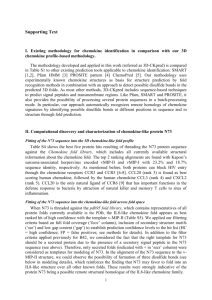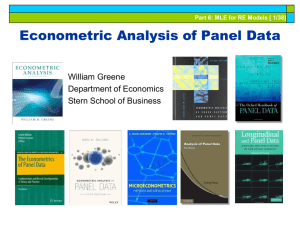b-values and Spatial Variability - Working Group on California
advertisement
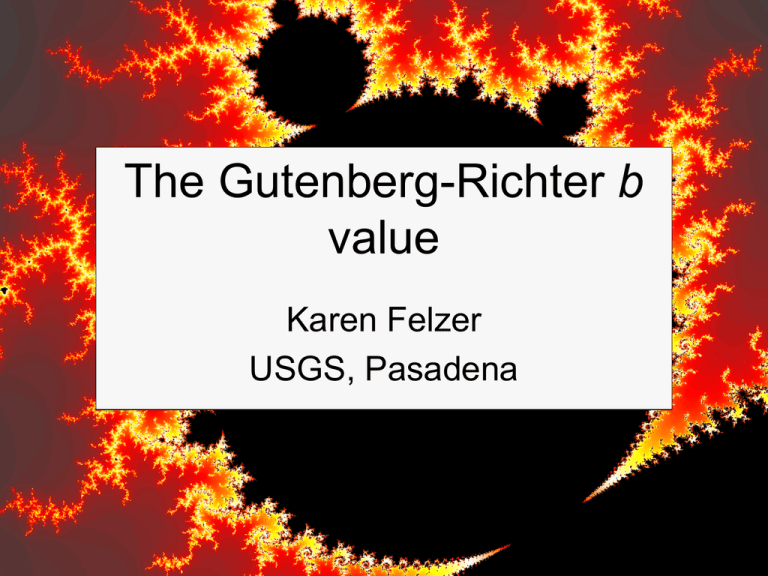
The Gutenberg-Richter b value Karen Felzer USGS, Pasadena The global magnitude-frequency relationship: Gutenberg-Richter with b=1 1976-2005 Global CMT catalog Slope = b =1.0 log(N) = a - bM Hutton et al. (2010) obtained b=1.0 for Southern California Figure 13, Hutton et al. (2010) Lower b values are often reported because it is easy to use a value of Mc that is too small Probability of earthquake detection = 1 - C10-M Setting the catalog completeness threshold by eye can lead to b value underestimation by 0.1 to 0.2. Magnitude error can also cause miscalculation of b values 1984-1999 Southern California Catalog b value inflated by magnitude error • • Larger magnitude errors for smaller earthquakes inflate b b is best fit at the largest reasonable minimum magnitude Erroneous b values also frequently result from data sets that are too small n b range 30 0.7 - 1.74 50 0.5 - 1.49 100 0.86 - 1.20 500 0.91 - 1.12 >2000 good quality earthquakes are required for 98% confidence errors < 0.05 Declustering reduces b value in routines where the smaller earthquakes in a cluster are preferentially removed Sorry, but according to our b value you didn’t have an earthquake! Christchurch, M 6.3 Does b value vary with location? The Wiemer and Schorlemmer method uses b value asperities and is #2 in the RELM test Weimer and Schorlemmer 5 year forecast The Helmstetter et al. forecast uses uniform b value and is #1 in the RELM test Helmstetter et al. 5 year forecast Case study: Wiemer and Schorlemmer (2007) argue that they see a lot of b value variability at Parkfield We can recover similar “variability” with a simulated catalog with a uniform b value, and the incompletness and rounding found in the Parkfield catalog Two random simulations Taking a statewide survey, we find little b value variation in 1° x 1° bins 1984 - 2004 Minimum of 30 earthquakes/calculation Assuming no magnitude error and uniform catalog completeness to M 2.6, all values are 0.9 ≤ b ≤1.1. Same for 0.5 °x 0.5 °, 0.25 °x 0.25 °, 0.1° x Is the magnitude-frequency distribution different on and off of major faults? ? Quiz! Identify the distributions taken from major fault zones* (A) (B) (C) (D) (E) (F) *Fault zone: +-2 km from entire surface trace of mapped fault. All data from California, 1984-2004 Identify the distributions taken from major fault zones* Hayward Random (B) (A) SAJ (D) (C) Random (E) SAF Random (F) *Fault zone: +-2 km from entire surface trace of mapped fault All data from California, 1984-2004 Quiz #2! Identify the distributions taken from major fault zones (A) (B) (C) (D) All distributions are purposely chosen around a large earthquake. All data from California, 1984-2004 Identify the distributions taken from major fault zones Random Calaveras (A) (B) Garlock Random (C) (D) All of these earthquake distributions are purposely centered around a large earthquake in the catalog The San Andreas fault at Parkfield has b=1 M 6 Parkfield earthquakes are simply an expected part of the G-R distribution (Jackson and Kagan, 2006) Conclusions • Seismicity in most of California follows the Gutenberg-Richter magnitude frequency relationship with b=1. • There is no evidence for significant b value variation with location or on/off of major faults. • The b value should generally be solved for with >2000 earthquakes that are clearly above the completeness threshold and that have minimal magnitude errors or rounding. The historic record along the full SAF 1812-2006 eqs, ± 10 km from SAF Complete? Incomplete Catalog is too incomplete, short, and error-prone, but Gutenberg-Richter is suggested Common Errors in b value Calculation 1. Fitting data with linear least squares (LSQ) rather than the simple maximum likelihood (MLE) method (read Aki (1965)) 2. Data set is too small 3. Using earthquakes smaller than the catalog completeness threshold 4. Using data with magnitude errors Two Important Questions • Does b value vary with location? (Wiemer and Wyss, 1997; Schorlemmer and Wiemer, 2004…) • Does the magnitude-frequency distribution vary on and off of major faults? (Wesnousky et al. 1983; Schwartz and Coppersmith, 1984…) Error #1: Fitting with least squares rather than MLE b value solved from 100 trials with 500 simulated earthquakes each; true b=1.0. LSQ solutions • MLE solutions MLE solutions are closer to the true value of b Why the value of b is important Hazard Analysis: Small changes in b => large changes in projected numbers of major earthquakes Example 10 M ≥ 7 eqs 10,000 M ≥ 4 earthquakes 20 M ≥ 7 eqs Earthquake Physics: The magnitude distribution reflects fundamental properties of how earthquakes grow and stop. Error #1: Fitting with linear least squares (LSQ) rather than MLE LSQ assumes the error at each point is Gaussian rather than Poissonian LSQ assumes the error on each point is equal • LSQ is disproportionately influenced by the largest earthquakes • MLE weighs each earthquake equally






